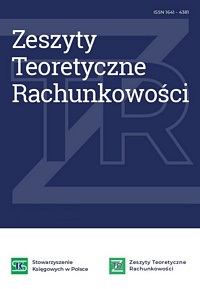Koszty ochrony lasu w zrównoważonej gospodarce leśnej. Przykład Polski
Forest protection costs in sustainable forest management. The example of Poland
Author(s): Beata SadowskaSubject(s): Economy, National Economy, Agriculture, Public Finances, Accounting - Business Administration
Published by: Stowarzyszenie Księgowych w Polsce
Keywords: costs; state forests; forest protection; sustainable forest management; reporting information
Summary/Abstract: Purpose: The main aim of the study is to analyze the costs of forest protection incurred by Poland's State Forests and to present the activities performed as part of forest protection. The specific objective is to present the method and place of disclosing and reporting information on actions to prevent damage to the forest and on the costs of forest protection on a general level. Methodology/approach: The considerations in the study are presented against the views presented in the literature on the subject by selected authors. The methods of criti-cal analysis and synthesis, inference, and a case study were used. The data for the analyses were taken from the financial and economic reports of the State Forests for the years 2016–2019, from the statistical studies „Forestry”, and reports obtained as part of the application submitted to the State Forests for the re-use of public sector information. Pearson's linear correlation analysis was used, as well as an agglomeration grouping method – Ward's method – which uses the analysis of variance approach in its procedures. Findings: The scale of forest protection measures varied between State Forests in the analyzed period. The highest costs for forest protection in total are borne by forest districts located in the area of State Forests in Wrocław, and the lowest costs for forest pro-tection in total are borne by forest districts located in the area of State Forests in Kraków. The smallest area protected against insects covers forest districts located in the State Forests in Krakow. With the increase in the costs of forest protection, State Forest’s own costs also increase. The highest relationship was noted in 2017, with a correla-tion coefficient of 0.86. Research limitations: The research sample is limited to one country. Originality/value: The presented voice in the discussion fills the research gap in terms of information about State Forests’ activities to protect the forest and the subsequent costs incurred. The use of Ward’s method allowed similar regional directorates of State Forests to be grouped from the perspective of forest protection costs and protective measures (area approach), which is the basis for extended research in this area from the point of view of the natural diversity of these units (narrowing the research and conduct-ing it in similar State Forests units).
Journal: Zeszyty Teoretyczne Rachunkowości
- Issue Year: 46/2022
- Issue No: 3
- Page Range: 161-179
- Page Count: 19
- Language: Polish

